I'll be on air with Rob Drieslein at Outdoor Talk on KTLK on Sunday at 5pm Central Time answering your bird questions. I have a feeling that the new Minnesota Sandhill Crane Hunt will be a hot topic. Studio line is 651-989-5855.
Uncertain Chickadee
 This young chickadee was not sure what to make of the grape jelly feeder. Ah, I love young birds as they try to figure out what is and is not food at the feeding station. The black-capped chickadee perched and stared for about 30 seconds, then flew to the sunflower feeder.
This young chickadee was not sure what to make of the grape jelly feeder. Ah, I love young birds as they try to figure out what is and is not food at the feeding station. The black-capped chickadee perched and stared for about 30 seconds, then flew to the sunflower feeder.
Careful What You Sign In The Name Of The Gulf
There's legislation being considered in both the House and Senate to address the BP Gulf Oil disaster that could fully fund the Land and Water Conservation Fund every year at $900 million annually for land conservation – including funding for national wildlife refuges. On Facebook and Twitter, petitions and letters to support this funding on behalf of taxpayers has been begging for our support. I'll admit up front, that I tend to fall on the side of wanting more money for habitat. I'd much rather my tax dollars go to managing our public refuge system than say a baseball stadium. I'm not opposed to more money for the Land and Water Conservation Fund. But, do you know who else is really excited about this legislation? BP!
Corey Finger had mentioned a few weeks ago that there was a suspicious looking environmental group called America's Wetland Foundation which has great ambiguous phrases on their website "Climate Energy and the Coast for a Sustainable Future." It also has some interesting sponsors which includes Shell, Chevron and BP. One of its partner organizations called Women of the Gulf has jumped on board to help support this legislation and created a petition and a YouTube video including such trustworthy celebrities as Sandra Bullock, Harry Shearer, Dave Matthews, Lenny Kravitz just to name of few to get you to sign.
Last night, Huffington Post released this story about America's Wetland Foundation and Women of the Gulf. Here's an excerpt:
"The America's WETLAND Foundation (AWF) was launched in 2002. It's run by the PR shop Marmillion+Company, whose founder previously served as a PR manager at ARCO and staffer to various GOPers.
According to the Washington Post: "Shell Oil, worried about its offshore drilling platforms, put up several million dollars for a PR campaign to rebrand Louisiana's marshes as 'America's Wetland.'"
Now Women of the Gulf was founded in January 2006 in response to the devastation wrought by Hurricane Katrina, Women of the Storm. Here's what HP found out:
"Anne Milling, founder of Women of the Storm, said in a phone interview that the organization has never received a penny directly from BP or any other major oil company, although she did acknowledge Women of the Storm received advisory assistance from some of these entities when originally launching the project after Hurricane Katrina.
Mrs. Milling was unapologetic when asked about the prominent placement of the America's Wetland Foundation banner on the group's website and its various partnerships with the oil-backed group. She sees nothing wrong with AWF's cozy relationship with the same oil and gas giants that are partly responsible for the coastal wetlands degradation that is the focus of her group's concern.
Why? Perhaps because she is married to R. King Milling, the chairman of America's Wetland Foundation, Mrs. Milling sees nothing wrong with the oil connections."
In the wake of this news, I see that Sandra Bullock has asked to have her part of the video pulled as she tries to sort out who she's actually helping here: wetlands get future funding or BP trying to get out of paying some money to help Gulf clean up of the spill they created.
For myself, I'm torn. I'm generally good with sending money to save public lands that I enjoy birding, digiscoping, hiking, canoeing and now fishing in. However, I'm not a fan of helping BP avoid some of the massive payouts they must do.
Also, I don't blame Ms. Bullock for her involvement. No woman makes good decisions after a bad breakup.
Let this be a reminder to all of us that we need to be careful about what we sign and who we send money to in the name of "saving the Gulf."
Trouble In The Bird Feeder Wren Nest!
Yesterday, I was out to check on the squirrel proof Feeder with the house wren nest. On Monday, Mr. Neil sent over photos showing that three of the four eggs had hatched. I wanted to see if the final egg hatched and found something completely unexpected:
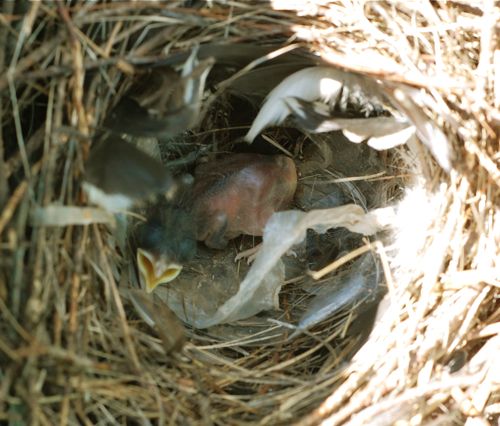
One chick and no eggs. Huh? What the heck happened? I have a couple of theories:
1. It was very hot on Tuesday--well into the 90s. This feeder is made of metal and gets late afternoon sun. Did the other chicks die from the heat and the wrens remove them?
2. A snake came up the pole and was able to eat the other chicks? But why is only one chick left? Usually snakes take everything...unless this was a really tiny snake?
I don't know. I did notice that the male didn't sing like he usually does--has he given up on the territory? I did see a wren leave the feeder a few times, so I know at least one of the pair is still feeding this chick. I'll be interested to see if this bird actually leaves the nest.
It's a demonstration of how wrens and many other bird species play the odds when raising chicks. They'll go for an extra brood, they'll try out a new next spot, they lay four to five eggs--if it works, great! If it doesn't, they'll know better next time.
Google Alerts On This Site
I've received several emails regarding the Google warning for my site--thanks so much for the head's up! It appears to have been a problem with the Fat Birder 500 button and when I try to go to Fat Birder, I get the same warning. Non Birding Bill removed the code from both the blog and from the RSS feed. However, certain RSS feeds may still have the code until they update. But it's gone and hopefully that will solve the problem.
Are These Oil Damaged Gulls?
I think I got an email report of oil damaged birds that are not the typical sludge covered birds we've seen in the media. I think every birder along the Gulf Coast needs to pay special attention to feathers on the tails and wings of wetland birds. All of the photos in this entry are by my buddy, Carrol Henderson. Carrol took some photos in Mobile, Alabama, last week (July 21 and 22, 2010) while attending the nongame technical section meeting of the Mississippi Flyway Council. Carrol is always taking photos and he got some interesting shots of laughing gulls.
Here is a photo of a laughing gull in typical, adult plumage:
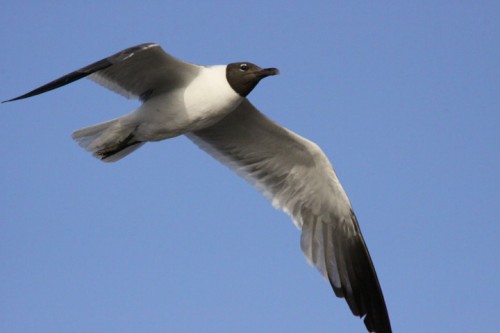
Note the above bird's tail feathers and wing feathers--they look strong and healthy. Now, take a look at this photo of a laughing gull:
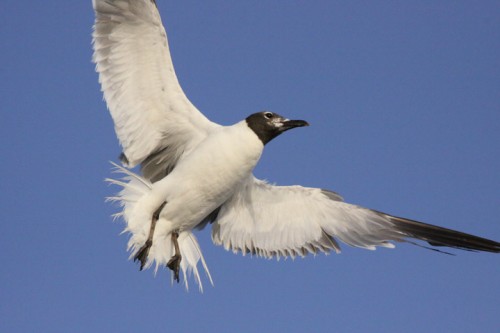
Carrol reported, "As I looked over the photos from the trip, I noticed that there were some gulls with very degraded tail feathers and secondaries. The veins of the feathers were missing along the tips." Not the pointy shafts on this bird? It has a little bit of white feathers around the bill--which is normal but those pointy feathers are not. How did that happen? And this wasn't the only gull with this feather pattern.

Carrol mentioned, "I have photographed many species of gulls in many countries in the past 20-plus years, but I have never observed this pattern of plumage degradation before. It does not appear related to the molt patterns of gulls, because they typically lose matching feathers from both wings in synchrony."
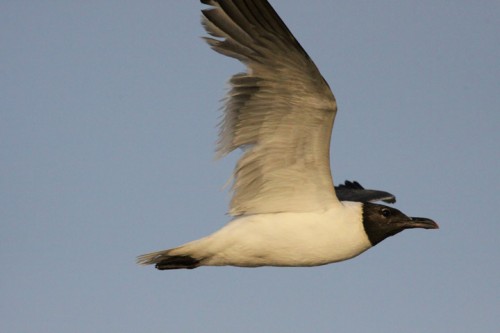
Carrol wonders if this could be the result of the veins breaking off of the feather shafts because of excessive preening after the feathers have been exposed to oil residue? Is it the oil itself? Is this the result of some of oil dispersant chemicals being used that the birds came into contact with while swimming on the water? Mobile is not far from the Gulf. Are there more birds out there with this sort of damage? This is not good news and this is subtle enough that these birds may get lost and unreported because you don't see oil on them directly.
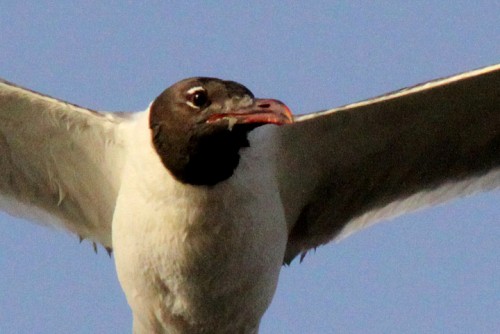
Carrol said this bird sported a “suspicious” brown residue on the bill--oil residue? Oil is bad enough, but this feather damage can be just as devastating to a bird that only molts once a year. And if it's affecting local gulls, what will happen when birds from all over North America migrate south and land in the marshes?
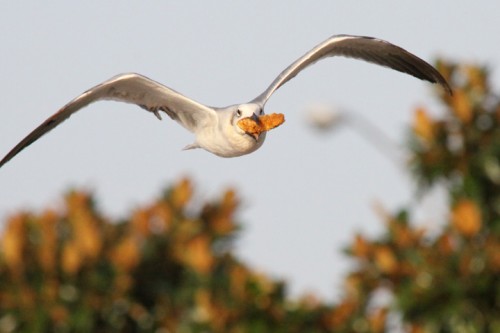
A local laughing gull relying on scavenging trash and taking chicken finger handouts from humans might be able to survive this feather damage. But what about a migrating sora? Or a migrating common yellowthroat? A migrating green heron? How can a bird go the long distance with such dramatic feather damage to the tail and wings?
Random House Finch

Have You Seen The Sibley Poster?
David Sibley has created a "backyard birds" poster. While I don't think this will replace the millions of Klimpt and Dali posters hanging on college students dorm room walls, I do think it will be very popular in kitchens and nature centers. The Sibley's Backyard Birds of Eastern North America poster features 98 common species in 144 illustrations--including both males and females of each species. It's a handy tool for backyard bird feeding stations...although, the poster does not include in any raptors, so if a Cooper's hawk or sharp-shinned hawk shows up, the poster won't help you with that one.

The poster does organize the birds into their family groups and the illustrations of each species are in relative scale to show differences in size. The posters run about $30 unframed (or $175 framed). According to this page, if you use the coupon code of "SIBLEYNEWS" when ordering, you can receive 10% off. This is sure to appeal to people who love this Sibley guide and who have backyard feeding stations.
Feeder Wrens Hatched!
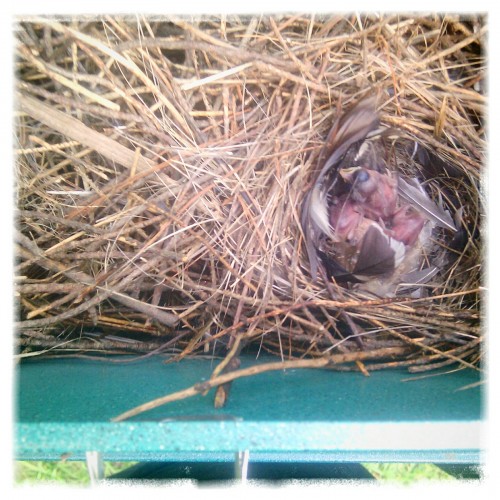 Last night on Twitter, Mr. Neil posted a photo alerting me that the house wrens in the squirrel proof feeder hatched. Look at those little naked chicks, they look fresh from the shell!
Last night on Twitter, Mr. Neil posted a photo alerting me that the house wrens in the squirrel proof feeder hatched. Look at those little naked chicks, they look fresh from the shell!
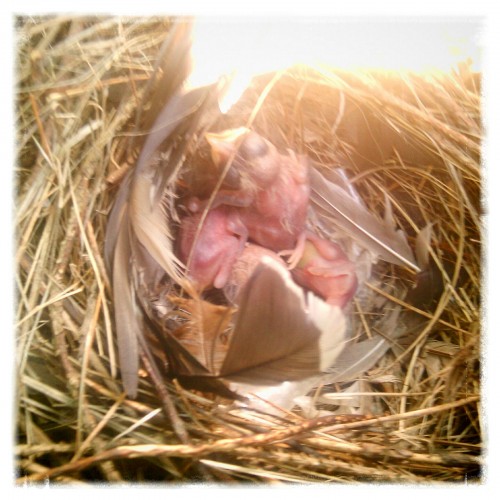 Look at the wee little toes! It looks like three of them have hatched and last I checked, there were four eggs. I'll be out on Wednesday to indulge in my fried green tomato habit (my all time favorite food outside of roasted eggplant with parmesan cheese...and well, bacon--but really, bacon should always go without saying). Anyway, I'll be out tomorrow to check on the hatchlings.
Look at the wee little toes! It looks like three of them have hatched and last I checked, there were four eggs. I'll be out on Wednesday to indulge in my fried green tomato habit (my all time favorite food outside of roasted eggplant with parmesan cheese...and well, bacon--but really, bacon should always go without saying). Anyway, I'll be out tomorrow to check on the hatchlings.
I looked at my original blog post on July 13 when I predicted that incubation would start on the 14th and twelve days of incubation. And what do you know? Yesterday, July 26 would have been 12 days of incubation! That means in two weeks or around August 8, the wrens will probably fledge. Then they have lots to learn on how to feed themselves and then the will commence to migratin'. They have a lot of work to do in a very little amount of time.
Birds and Beers This Thursday!
It's last minute, but there is a Birds and Beers this Thursday, July 29 at Merlin's Rest at 6pm! We can discuss the orange-billed nightengale thrush in South Dakota or strategies for applying to be president for the American Birding Association Presidency! Also, I booked the next Birds and Beers on Tuesday, August 17 at 6pm at Merlin's Rest.
What is Birds and Beers? It's an informal gathering of birders of ALL abilities to meet outside of the Internet and connect. Are you a hardcore lister--you're invited. Are you a researcher working on a cool project and want to recruit volunteers or just talk about your study--you're invited. Are you someone who just enjoys the birds you see out of your kitchen window--you're invited. Are you a birding guide and want to promote your tours and business--you're invited. Are you someone who has heard of this whole bird watching thing and want to see what it's all about--you're invited! Looking for birders to volunteer at a booth for the State Fair--you're invited!
It's low key and it's fun. Maybe you'll find a new friend to enjoy birds in the field? Maybe you'll learn that secret spot to finally see a Henslow's sparrow? Maybe you'll learn some tips on thwarting grackles from your feeder?

